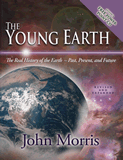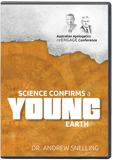
Chapter 10
Evidence for a Young Earth and Creation
The earth is only a few thousand years old. That’s a fact, plainly revealed in God’s Word. So we should expect to find plenty of evidence for a young earth. And that’s what we find — in the earth’s geology, biology, paleontology, and even astronomy.
Literally hundreds of dating methods could be used to attempt an estimate of the earth’s age, and the vast majority of them point to a much younger earth than the 4.5 billion years claimed by secularists. The following series of articles presents what Answers in Genesis researchers picked as the ten best scientific evidences that contradict billions of years and confirm a relatively young earth and universe.
Despite this wealth of evidence, it is important to understand that, from the perspective of observational science, no one can prove absolutely how young (or old) the universe is. Only one dating method is absolutely reliable — a witness who doesn’t lie, who has all evidence, and who can reveal to us when the universe began!
And we do have such a witness — the God of the Bible! He has given us a specific history, beginning with the six days of creation and followed by detailed genealogies that allow us to determine when the universe began. Based on this history, the beginning was only about six thousand years ago (about four thousand years from creation to Christ).
In the rush to examine all these amazing scientific “evidences,” it’s easy to lose sight of the big picture. Such a mountain of scientific evidence, accumulated by researchers, seems to obviously contradict the supposed billions of years, so why don’t more people rush to accept the truth of a young earth based on the Bible?
The problem is, as we consider the topic of origins, all so-called “evidences” must be interpreted. Facts don’t speak for themselves. Interpreting the facts of the present becomes especially difficult when reconstructing the historical events that produced those present-day facts, because no humans have always been present to observe all the evidence and to record how all the evidence was produced.
Forensic scientists must make multiple assumptions about things they cannot observe. How was the original setting different? Were different processes in play? Was the scene later contaminated? Just one wrong assumption or one tiny piece of missing evidence could totally change how they reconstruct the past events that led to the present-day evidence.
When discussing the age of the earth, Christians must be ready to explain the importance of starting points. The Bible is the right starting point. This is the revealed Word of the almighty, faithful, and true Creator, who was present to observe all events of earth history and who gave mankind an infallible record of key events in the past.
The Bible, God’s revelation to us, gives us the foundation that enables us to begin to build the right worldview to correctly understand how the present and past are connected. All other documents written by man are fallible, unlike the “God-breathed” infallible Word (2 Timothy 3:16). The Bible clearly and unmistakably describes the creation of the universe, the solar system, and the earth around six thousand years ago. We know that it’s true based on the authority of God’s own character. “Because He could swear by no one greater, He swore by Himself” (Hebrews 6:13).
In one sense, God’s testimony is all we need; but God Himself tells us to give reasons for what we believe (1 Peter 3:15). So it is also important to conduct scientific research (that is part of taking dominion of the earth, as Adam was told to do in Genesis 1:28). With this research we can challenge those who reject God’s clear Word and defend the biblical worldview.
Indeed, God’s testimony must have such a central role in our thinking that it seems demeaning even to call it the “best” evidence of a young earth. It is, in truth, the only foundation upon which all other evidences can be correctly understood!
Following are the ten best evidences from science that confirm a young earth and creation.
#1: Very Little Sediment on the Seafloor
If sediments have been accumulating on the seafloor for three billion years, the seafloor should be choked with sediments many miles deep.
Every year, water and wind erode about 20 billion tons of dirt and rock debris from the continents and deposit them on the seafloor1 (figure 1). Most of this material accumulates as loose sediments near the continents. Yet the average thickness of all these sediments globally over the whole seafloor is not even 1,300 feet (400 m).2
Some sediments appear to be removed as tectonic plates slide slowly (an inch or two per year) beneath continents. An estimated 1 billion tons of sediments are removed this way each year.3 The net gain is thus 19 billion tons per year. At this rate, 1,300 feet of sediment would accumulate in less than 12 million years, not billions of years.

Figure 1. Every year, 20 billion tons of dirt and rock debris wash into the ocean and accumulate on the seafloor. Only 1 billion tons (5 percent) are removed by tectonic plates. At this rate, the current thickness of the seafloor sediment would accumulate in less than 12 million years. Such sediments are easily explained by water draining off the continents toward the end of the Flood.
This evidence makes sense within the context of the Genesis Flood cataclysm, not the idea of slow and gradual geologic evolution. In the latter stages of the year-long global Flood, water swiftly drained off the emerging land, dumping its sediment-chocked loads offshore. Thus most seafloor sediments accumulated rapidly about 4,350 years ago.4
Rescuing Devices
Those who advocate an old earth insist that the seafloor sediments must have accumulated at a much slower rate in the past. But this rescuing device doesn’t “stack up”! Like the sediment layers on the continents, the sediments on the continental shelves and margins (the majority of the seafloor sediments) have features that unequivocally indicate they were deposited much faster than today’s rates. For example, the layering and patterns of various grain sizes in these sediments are the same as those produced by undersea landslides, when dense debris-laden currents (called turbidity currents) flow rapidly across the continental shelves and the sediments then settle in thick layers over vast areas. An additional problem for the old-earth view is that no evidence exists of much sediment being subducted and mixed into the mantle.
#2: Bent Rock Layers
In many mountainous areas, rock layers thousands of feet thick have been bent and folded without fracturing. How can that happen if they were laid down separately over hundreds of millions of years and already hardened?
Hardened rock layers are brittle. Try bending a slab of concrete sometime to see what happens! But if concrete is still wet, it can easily be shaped and molded before the cement sets. The same principle applies to sedimentary rock layers. They can be bent and folded soon after the sediment is deposited, before the natural cements have a chance to bind the particles together into hard, brittle rocks.5
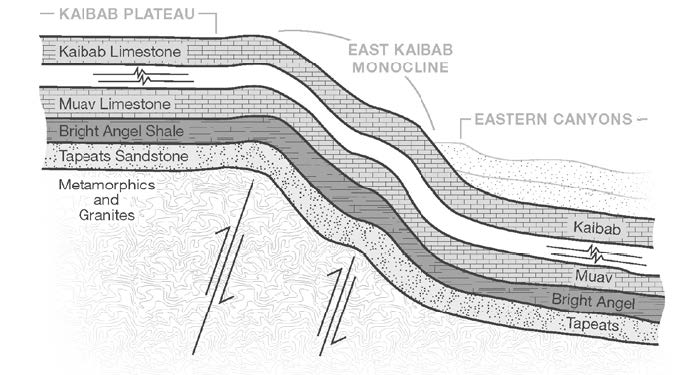
Figure 2. The Grand Canyon now cuts through many rock layers. Previously, all these layers were raised to their current elevation (a raised, flat region known as the Kaibab Plateau). Somehow this whole sequence was bent and folded without fracturing. That’s impossible if the first layer, the Tapeats Sandstone, was deposited over North America 460 million years before being folded. But all the layers would still be relatively soft and pliable if it all happened during the recent, global Flood.
The region around Grand Canyon is a great example showing how most of the earth’s fossil-bearing layers were laid down quickly and many were folded while still wet. Exposed in the canyon’s walls are about 4,500 feet (1,370 m) of fossil-bearing layers, conventionally labeled Cambrian to Permian.6 They were supposedly deposited over a period lasting from 520 to 250 million years ago. Then, amazingly, this whole sequence of layers rose over a mile, around 60 million years ago. The plateau through which Grand Canyon runs is now 7,000–8,000 feet (2,150–3,450 m) above sea level.
Think about it. The time between the first deposits at Grand Canyon (520 million years ago) and their bending (60 million years ago) was 460 million years!
Look at the photos on the following page of some of these layers at the edge of the plateau, just east of the Grand Canyon. The whole sequence of these hardened sedimentary rock layers has been bent and folded, but without fracturing (figure 2).7 At the bottom of this sequence is the Tapeats Sandstone, which is 100–325 feet (30–100 meters) thick. It is bent and folded 90° (photo 1). The Muav Limestone above it has similarly been bent (photo 2).
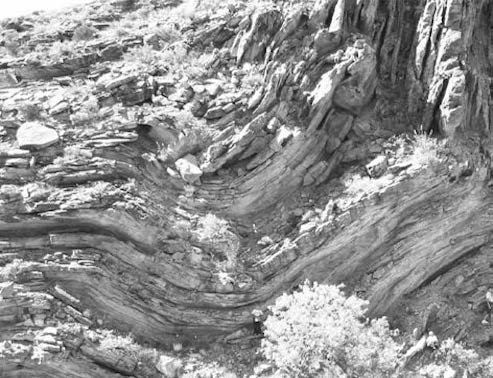
Photo 1. The whole sequence of sedimentary layers through which Grand Canyon cuts has been bent and folded without fracturing. This includes the Tapeats Sandstone, located at the bottom of the sequence. (A 90° fold in the eastern Grand Canyon is pictured here.) | 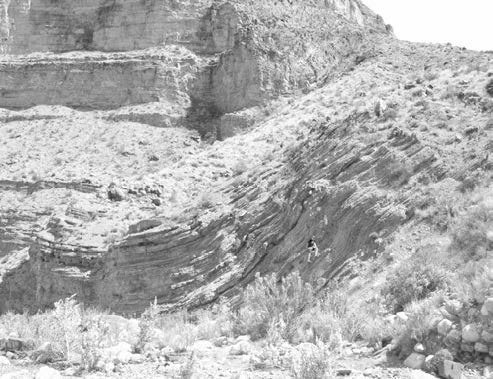
Photo 2. Photo 2. All the layers through which Grand Canyon cuts — including the Muav Limestone shown here — have been bent without fracturing.) |

Figure 3. This phenomenon was not regional. The Tapeats Sandstone spans the continent, and other layers span much of the globe.
However, it supposedly took 270 million years to deposit these particular layers. Surely in that time the Tapeats Sandstone at the bottom would have dried out and the sand grains cemented together, especially with 4,000 feet (1,220 m) of rock layers piled on top of it and pressing down on it. The only viable scientific explanation is that the whole sequence was deposited very quickly — the creation model indicates that it took less than a year, during the global Flood cataclysm. So the 520 million years never happened, and the earth is young.
Rescuing Devices
What solution do old-earth advocates suggest? Heat and pressure can make hard rock layers pliable, so they claim this effect must be what happened in the eastern Grand Canyon, as the sequence of many layers above pressed down and heated up these rocks. Just one problem. The heat and pressure would have transformed these layers into quartzite, marble, and other metamorphic rocks. Yet Tapeats Sandstone is still sandstone, a sedimentary rock!
But this quandary is even worse for those who deny God’s recent creation and the Flood. The Tapeats Sandstone and its equivalents can be traced right across North America (figure 3)8 and beyond to right across northern Africa to southern Israel.9 Indeed, the whole Grand Canyon sedimentary sequence is an integral part of six megasequences that cover North America.10 Only a global Flood cataclysm could carry the sediments to deposit thick layers across several continents one after the other in rapid succession in one event.11
#3 Soft Tissue in Fossils
Ask the average layperson how he or she knows that the earth is millions or billions of years old, and that person will probably mention the dinosaurs, which nearly everybody “knows” died off 65 million years ago. A recent discovery by Dr. Mary Schweitzer, however, has given reason for all but committed evolutionists to question this assumption.
Bone slices from the fossilized thigh bone (femur) of a Tyrannosaurus rex found in the Hell Creek Formation of Montana were studied under the microscope by Schweitzer. To her amazement, the bone showed what appeared to be blood vessels of the type seen in bone and marrow, and these contained what appeared to be red blood cells with nuclei, typical of reptiles and birds (but not mammals). The vessels even appeared to be lined with specialized endothelial cells found in all blood vessels.
Amazingly, the bone marrow contained what appeared to be flexible tissue. Initially, some skeptical scientists suggested that bacterial biofilms (dead bacteria aggregated in a slime) formed what only appear to be blood vessels and bone cells. Recently, Schweitzer and co-workers found biochemical evidence for intact fragments of the protein collagen, which is the building block of connective tissue. This is important because collagen is a highly distinctive protein not made by bacteria.12
Some evolutionists have strongly criticized Schweitzer’s conclusions because they are understandably reluctant to concede the existence of blood vessels, cells with nuclei, tissue elasticity, and intact protein fragments in a dinosaur bone dated at 68 million years old. Other evolutionists, who find Schweitzer’s evidence too compelling to ignore, simply conclude that there is some previously unrecognized form of fossilization that preserves cells and protein fragments over tens of millions of years.13 Needless to say, no evolutionist has publically considered the possibility that dinosaur fossils are not millions of years old.
An obvious question arises from Schweitzer’s work: is it even remotely plausible that blood vessels, cells, and protein fragments can exist largely intact over 68 million years? While many consider such long-term preservation of tissue and cells to be very unlikely, the problem is that no human or animal remains are known with certainty to be 68 million years old (figure 4). But if creationists are right, most dinosaurs were buried in the Flood 3,000 to 4,000 years ago. So would we expect the preservation of vessels, cells, and complex molecules of the type that Schweitzer reports for biological tissues historically known to be 3,000 to 4,000 years old?
The answer is yes. Many studies of Egyptian mummies and other humans of this old age (confirmed by historical evidence) show all the sorts of detail Schweitzer reported in her T. rex. In addition to Egyptian mummies, the Tyrolean iceman, found in the Alps in 1991 and believed to be about 5,000 years old according to long-age dating, shows such incredible preservation of DNA and other microscopic detail.
We conclude that the preservation of vessels, cells, and complex molecules in dinosaurs is entirely consistent with a young-earth creationist perspective but is highly implausible with the evolutionist’s perspective about dinosaurs that died off millions of years ago.
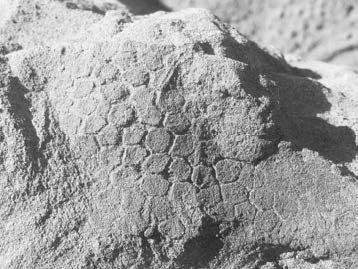
Figure 4. A little skin: a largely intact dinosaur mummy, named Dakota, was found in the Hell Creek Formation of the western United States in 2007. Some soft tissue from the long-necked hadrosaur was quickly preserved as fossil, such as the scales from its forearm shown here.
#4: Faint Sun Paradox
Evidence now supports astronomers’ belief that the sun’s power comes from the fusion of hydrogen into helium deep in the sun’s core, but there is a huge problem. As the hydrogen fuses, it should change the composition of the sun’s core, gradually increasing the sun’s temperature. If true, this means that the earth was colder in the past. In fact, the earth would have been below freezing 3.5 billion years ago, when life supposedly evolved.
The rate of nuclear fusion depends upon the temperature. As the sun’s core temperatures increase, the sun’s energy output should also increase, causing the sun to brighten over time. Calculations show that the sun would brighten by 25 percent after 3.5 billion years. This means that an early sun would have been fainter, warming the earth 31°F (17°C) less than it does today. That’s below freezing!
But evolutionists acknowledge that there is no evidence of this in the geologic record. They even call this problem the faint young sun paradox. While this isn’t a problem over many thousands of years, it is a problem if the world is billions of years old.
Rescuing Devices
Over the years, scientists have proposed several mechanisms to explain away this problem. These suggestions require changes in the earth’s atmosphere. For instance, more greenhouse gases early in earth’s history would retain more heat, but this means that the greenhouse gases had to decrease gradually to compensate for the brightening sun.
None of these proposals can be proved, for there is no evidence. Furthermore, it is difficult to believe that a mechanism totally unrelated to the sun’s brightness could compensate for the sun’s changing emission so precisely for billions of years.
#5: Rapidly Decaying Magnetic Field
The earth is surrounded by a magnetic field that protects living things from solar radiation. Without it, life could not exist. That’s why scientists were surprised to discover that the field is quickly wearing down. At the current rate, the field and thus the earth could be no older than 20,000 years old.
Several measurements confirm this decay. Since measuring began in 1845, the total energy stored in the earth’s magnetic field has been decaying at a rate of 5 percent per century.14 Archaeological measurements show that the field was 40 percent stronger in a.d. 1000.15 Recent records of the International Geomagnetic Reference Field, the most accurate ever taken, show a net energy loss of 1.4 percent in just three decades (1970–2000).16 This means that the field’s energy has halved every 1,465 years or so.
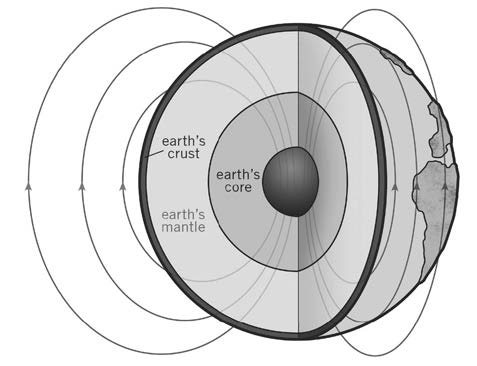
Figure 5. Creationists have proposed that the earth’s magnetic field is caused by a freely decaying electric current in the earth’s core. (Old-earth scientists are forced to adopt a theoretical, self-sustaining process known as the dynamo model, which contradicts some basic laws of physics.) Reliable, accurate, published geological field data have emphatically confirmed this young-earth model.
Creationists have proposed that the earth’s magnetic field is caused by a freely decaying electric current in the earth’s core. This means that the electric current naturally loses energy, or “decays,” as it flows through the metallic core. Though it differs from the most commonly accepted conventional model, it is consistent with our knowledge of what makes up the earth’s core.17 Furthermore, based on what we know about the conductive properties of liquid iron, this freely decaying current would have started when the earth’s outer core was formed. However, if the core were more than 20,000 years old, then the starting energy would have made the earth too hot to be covered by water, as Genesis 1:2 reveals.
Reliable, accurate, published geological field data have emphatically confirmed the young-earth model: a freely decaying electric current in the outer core is generating the magnetic field.18 Although this field reversed direction several times during the Flood cataclysm when the outer core was stirred (figure 5), the field has rapidly and continuously lost total energy ever since creation (figure 6). It all points to an earth and magnetic field only about 6,000 years old.19
Rescuing Devices
Old-earth advocates maintain the earth is over 4.5 billion years old, so they believe the magnetic field must be self-sustaining. They propose a complex, theoretical process known as the dynamo model, but such a model contradicts some basic laws of physics. Furthermore, their model fails to explain the modern, measured electric current in the seafloor.20 Nor can it explain the past field reversals, computer simulations notwithstanding.21
To salvage their old earth and dynamo, some have suggested the magnetic field decay is linear rather than exponential, in spite of the historic measurements and decades of experiments confirming the exponential decay. Others have suggested that the strength of some components increases to make up for other components that are decaying. That claim results from confusion about the difference between magnetic field intensity and its energy, and has been refuted categorically by creation physicists.22
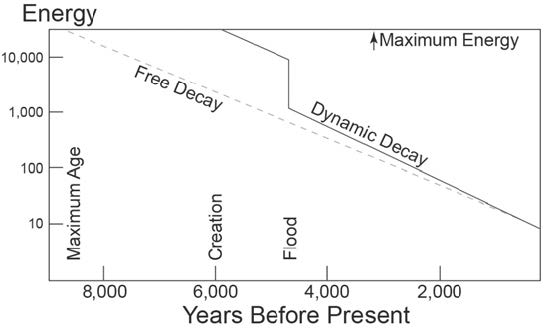
Figure 6. The earth’s magnetic field has rapidly and continuously lost total energy since its origin, no matter which model has been adopted to explain its magnetism. According to creationists’ dynamic decay model, the earth’s magnetic field lost more energy during the Flood, when the outer core was stirred and the field reversed direction several times.
#6: Helium in Radioactive Rocks
During the radioactive decay of uranium and thorium contained in rocks, lots of helium is produced. Because helium is the second lightest element and a noble gas — meaning it does not combine with other atoms — it readily diffuses (leaks) out and eventually escapes into the atmosphere. Helium diffuses so rapidly that all the helium should have leaked out in less than 100,000 years. So why are these rocks still full of helium atoms?
While drilling deep Precambrian (pre-Flood) granitic rocks in New Mexico, geologists extracted samples of zircon (zirconium silicate) crystals from different depths. The crystals contained not only uranium but also large amounts of helium.23 The hotter the rocks, the faster the helium should escape, so researchers were surprised to find that the deepest, and therefore hottest, zircons (at 387°F or 197°C) contained far more helium than expected. Up to 58 percent of the helium that the uranium could have ever generated was still present in the crystals.

Figure 7. Radioactive elements in rocks produce a lot of helium as they decay; and this gas quickly slips away into the atmosphere, especially when the rocks are hot. Yet radioactive rocks in the earth’s crust contain a lot of helium. The only possible explanation: the helium hasn’t had time to escape!
The helium leakage rate has been determined in several experiments.24 All measurements are in agreement. Helium diffuses so rapidly that all the helium in these zircon crystals should have leaked out in less than 100,000 years. The fact that so much helium is still there means they cannot be 1.5 billion years old, as uranium-lead dating suggests. Indeed, using the measured rate of helium diffusion, these pre-Flood rocks have an average “diffusion age” of only 6,000 (± 2,000) years.25
These experimentally determined and repeatable results, based on the well-understood physical process of diffusion, thus emphatically demonstrate that these zircons are only a few thousand years old. The supposed 1.5-billion-year age is based on the unverifiable assumptions of radioisotope dating that are radically wrong.26
Another evidence of a young earth is the low amount of helium in the atmosphere. The leakage rate of helium gas into the atmosphere has been measured. 27 Even though some helium escapes into outer space, the amount still present is not nearly enough if the earth is over 4.5 billion years old (figure 7).28 In fact, if we assume no helium was in the original atmosphere, all the helium would have accumulated in only 1.8 million years even from an evolutionary standpoint.29 But when the catastrophic Flood upheaval is factored in, a flood which rapidly released huge amounts of helium into the atmosphere, it could have accumulated in only 6,000 years.30
Rescuing Devices
So glaring and devastating is the surprisingly large amount of helium that old-earth advocates have attempted to discredit this evidence.
One critic suggested the helium didn’t all come from uranium decay in the zircon crystals but a lot diffused into them from the surrounding minerals. But this proposal ignores measurements showing that less helium gas is in the surrounding minerals. Due to the well-established diffusion law of physics, gases always diffuse from areas of higher concentration to surrounding areas of lower concentration.31
Another critic suggested the edges of the zircon crystals must have stopped the helium from leaking out, effectively “bottling” the helium within the zircons. However, this postulation has also been easily refuted because the zircon crystals are wedged between flat mica sheets, not wrapped in them, so that helium could easily flow between the sheets unrestricted.32 All other critics have been answered.33 Thus all available evidence confirms that the true age of these zircons and their host granitic rock is only 6,000 (± 2,000) years.
#7: Carbon-14 in Fossils, Coal, and Diamonds
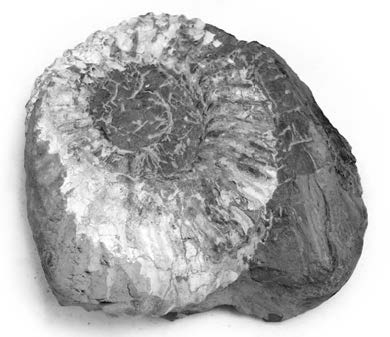
Figure 8. A sea creature, called an ammonite, was discovered near Redding, California, accompanied by fossilized wood. Both fossils are claimed by strata dating to be 112–120 million years old but yielded radiocarbon ages of only thousands of years.
Carbon-14 (or radiocarbon) is a radioactive form of carbon that scientists use to date fossils. But it decays so quickly — with a half-life of only 5,730 years — that none is expected to remain in fossils after only a few hundred thousand years. Yet carbon-14 has been detected in “ancient” fossils — supposedly up to hundreds of millions of years old — ever since the earliest days of radiocarbon dating.34
Even if every atom in the whole earth were carbon-14, they would decay so quickly that no carbon-14 would be left on earth after only 1 million years. Contrary to expectations, between 1984 and 1998 alone, the scientific literature reported carbon-14 in 70 samples that came from fossils, coal, oil, natural gas, and marble representing the fossil-bearing portion of the geologic record, supposedly spanning more than 500 million years. All contained radiocarbon.35 Further, analyses of fossilized wood and coal samples, supposedly spanning 32–350 million years in age, yielded ages between 20,000 and 50,000 years using carbon-14 dating.36 The fossilized sea creature and wood in figure 8 both yield radiocarbon ages of only thousands of years. Diamonds supposedly 1 to 3 billion years old similarly yielded carbon-14 ages of only 55,000 years.37
Even that is too old when you realize that these ages assume that the earth’s magnetic field has always been constant. But it was stronger in the past, protecting the atmosphere from solar radiation and reducing the radiocarbon production. As a result, past creatures had much less radiocarbon in their bodies, and their deaths occurred much more recently than reported!
So the radiocarbon ages of all fossils and coal should be reduced to less than 5,000 years, matching the timing of their burial during the Flood. The age of diamonds should be reduced to the approximate time of biblical creation — about 6,000 years ago.38
Rescuing Devices
Old-earth advocates repeat the same two hackneyed defenses, even though they were resoundingly demolished years ago. The first cry is, “It’s all contamination.” Yet for 30 years, AMS radiocarbon laboratories have subjected all samples, before they carbon-14 date them, to repeated brutal treatments with strong acids and bleaches to rid them of all contamination.39 And when the instruments are tested with blank samples, they yield zero radiocarbon, so there can’t be any contamination or instrument problems.
The second cry is, “New radiocarbon was formed directly in the fossils when nearby decaying uranium bombarded traces of nitrogen in the buried fossils.” Carbon-14 does form from such transformation of nitrogen, but actual calculations demonstrate conclusively this process does not produce the levels of radiocarbon that world-class laboratories have found in fossils, coal, and diamonds.40
#8: Short-Lived Comets
A comet spends most of its time far from the sun in the deep freeze of space. But once each orbit, a comet comes very close to the sun, allowing the sun’s heat to evaporate much of the comet’s ice and dislodge dust to form a beautiful tail. Comets have little mass, so each close pass to the sun greatly reduces a comet’s size, and eventually comets fade away. They can’t survive billions of years.
Two other mechanisms can destroy comets — ejections from the solar system and collisions with planets. Ejections happen as comets pass too close to the large planets, particularly Jupiter, and the planets’ gravity kicks them out of the solar system. While ejections have been observed many times, the first observed collision was in 1994, when Comet Shoemaker-Levi IX slammed into Jupiter.
Given the loss rates, it’s easy to compute a maximum age of comets. That maximum age is only a few million years. Obviously, their prevalence makes sense if the entire solar system was created just a few thousand years ago, but not if it arose billions of years ago.
Rescuing Devices
Evolutionary astronomers have answered this problem by claiming that comets must come from two sources. They propose that a Kuiper belt beyond the orbit of Neptune hosts short-period comets (comets with orbits under 200 years), and a much larger, distant Oort cloud hosts long-period comets (comets with orbits over 200 years).
Yet there is no evidence for the supposed Oort cloud, and there likely never will be. In the past 20 years, astronomers have found thousands of asteroids orbiting beyond Neptune, and they are assumed to be the Kuiper belt. However, the large size of these asteroids (Pluto is one of the larger ones) and the difference in composition between these asteroids and comets argue against this conclusion.
#9: Very Little Salt in the Sea
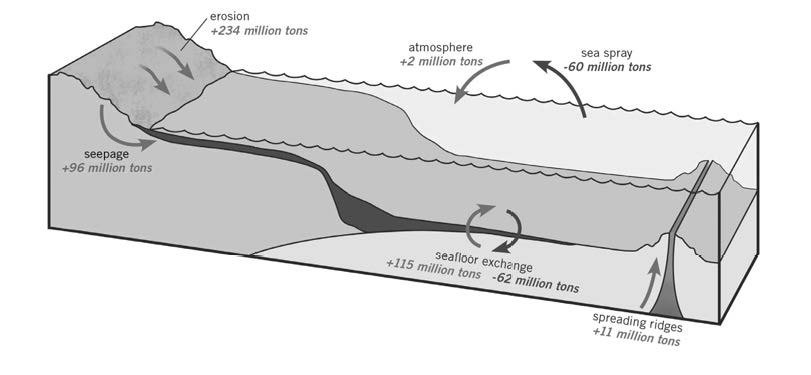
Figure 9. Every year, the continents, atmosphere, and seafloor add 458 million tons of salt into the ocean, but only 122 million tons (27 percent) is removed. At this rate, today’s saltiness would be reached in 42 million years. But God originally created a salty ocean for sea creatures, and the Flood quickly added more salt.
If the world’s oceans have been around for three billion years as evolutionists believe, they should be filled with vastly more salt than the oceans contain today.
Every year rivers, glaciers, underground seepage, and atmospheric and volcanic dust dump large amounts of salts into the oceans (figure 9). Consider the influx of the predominant salt, sodium chloride (common table salt). Some 458 million tons of sodium mixes into ocean water each year,41 but only 122 million tons (27 percent) is removed by other natural processes.42
If seawater originally contained no sodium (salt) and the sodium accumulated at today’s rates, then today’s ocean saltiness would be reached in only 42 million years43 — only about 1/70 the three billion years evolutionists propose. But those assumptions fail to take into account the likelihood that God created a saltwater ocean for all the sea creatures He made on day 5. Also, the yearlong global Flood cataclysm must have dumped an unprecedented amount of salt into the ocean through erosion, sedimentation, and volcanism. So today’s ocean saltiness makes much better sense within the biblical time scale of about six thousand years.44
Rescuing Devices
Those who believe in a three-billion-year-old ocean say that past sodium inputs had to be less and outputs greater. However, even the most generous estimates can only stretch the accumulation time frame to 62 million years.45 Long-agers also argue that huge amounts of sodium are removed during the formation of basalts at mid-ocean ridges,46 but this ignores the fact that the sodium returns to the ocean as seafloor basalts move away from the ridges.47
#10: DNA in “Ancient” Bacteria
In 2000, scientists claimed to have “resurrected” bacteria, named Lazarus bacteria, discovered in a salt crystal conventionally dated at 250 million years old. They were shocked that the bacteria’s DNA was very similar to modern bacterial DNA. If the modern bacteria were the result of 250 million years of evolution, its DNA should be very different from the Lazarus bacteria (based on known mutation rates). In addition, the scientists were surprised to find that the DNA was still intact after the supposed 250 million years. DNA normally breaks down quickly, even in ideal conditions. Even evolutionists agree that DNA in bacterial spores (a dormant state) should not last more than a million years. Their quandary is quite substantial.
However, the discovery of Lazarus bacteria is not shocking or surprising when we base our expectations on the Bible accounts. For instance, Noah’s Flood likely deposited the salt beds that were home to the bacteria. If the Lazarus bacteria are only about 4,350 years old (the approximate number of years that have passed since the worldwide flood), their DNA is more likely to be intact and similar to modern bacteria.
Rescuing Devices
Some scientists have dismissed the finding and believe the Lazarus bacteria are contamination from modern bacteria. But the scientists who discovered the bacteria defend the rigorous procedures used to avoid contamination. They claim the old age is valid if the bacteria had longer generation times, different mutation rates, and/or similar selection pressures compared to modern bacteria. Of course these “rescuing devices” are only conjectures to make the data fit their worldview.
The New Answers Book 4
Building on the previous New Answers Books, learn more about the Gospel and a young earth, death of plants and leaves, dragons, religious wars, cavemen, science, living fossils, and more.
Read Online Buy BookFootnotes
- John D. Milliman and James P. N. Syvitski, “Geomorphic/Tectonic Control of Sediment Discharge to the Ocean: The Importance of Small Mountainous Rivers,” The Journal of Geology 100 (1992): p. 525–544.
- William W. Hay, James L. Sloan II, and Christopher N. Wold, “Mass/Age Distribution and Composition of Sediments on the Ocean Floor and the Global Rate of Sediment Subduction,” Journal of Geophysical Research 93, no. B12 (1998): p. 14,933–14,940.
- Ibid.
- For a fuller treatment and further information see John D. Morris, The Young Earth (Green Forest, AR: Master Books, 2000), p. 88–90; Andrew A. Snelling, Earth’s Catastrophic Past: Geology, Creation and the Flood (Dallas, TX: Institute for Creation Research, 2009), p. 881–884.
- R.E. Goodman, Introduction to Rock Mechanics (New York: John Wiley and Sons, 1980); Sam Boggs Jr., Principles of Sedimentology and Stratigraphy (Upper Saddle River, NJ: Prentice-Hall, 1995), p. 127–131.
- Stanley S. Beus and Michael Morales, eds., Grand Canyon Geology, 2nd edition (New York: Oxford University Press, 2003).
- Andrew A. Snelling, “Rock Layers Folded, Not Fractured,” Answers 4, no. 2 (April–June 2009): p. 80–83.
- F. Alan Lindberg, Correlation of Stratigraphic Units of North America (COSUNA), Correlation Charts Series (Tulsa, OK: American Association of Petroleum Geologists, 1986).
- Andrew A. Snelling, “The Geology of Israel within the Biblical Creation-Flood Framework of History: 2. The Flood Rocks,” Answers Research Journal 3 (2010): p. 267–309.
- L.L. Sloss, “Sequences in the Cratonic Interior of North America,” Geological Society of America Bulletin 74 (1963): p. 93–114.
- For a fuller treatment and further information see Morris, The Young Earth, p. 106–109; Snelling, Earth’s Catastrophic Past: Geology, Creation and the Flood, p. 528–530, 597–605.
- See Schweitzer’s review article, “Blood from Stone,” Scientific American (December 2010): p. 62–69.
- Marcus Ross, “Those Not-So-Dry Bones,” Answers (Jan–Mar 2010): p. 43–45.
- A.L. McDonald and R.H. Gunst, “An Analysis of the Earth’s Magnetic Field from 1835 to 1965,” ESSA Technical Report, IER 46-IES 1 (Washington, DC: U.S. Government Printing Office, 1967).
- R.T. Merrill and M.W. McElhinney, The Earth’s Magnetic Field (London: Academic Press, 1983), p. 101–106.
- These measurements were gathered by the International Geomagnetic Reference Field. See D. Russell Humphreys, “The Earth’s Magnetic Field Is Still Losing Energy,” Creation Research Society Quarterly 39, no. 1 (2002): p. 1–11.
- Thomas G. Barnes, “Decay of the Earth’s Magnetic Field and the Geochronological Implications,” Creation Research Society Quarterly 8, no. 1 (1971): p. 24–29; Thomas G. Barnes, Origin and Destiny of the Earth’s Magnetic Field, Technical Monograph no. 4, 2nd edition (Santee, CA: Institute for Creation Research, 1983).
- D. Russell Humphreys, “Reversals of the Earth’s Magnetic Field During the Genesis Flood,” in Proceedings of the First International Conference on Creationism, vol. 2, R.E. Walsh, C.L. Brooks, and R.S. Crowell, eds. (Pittsburgh, PA: Creation Science Fellowship, 1986), p. 113–126.
- For a fuller treatment and further information see Morris, The Young Earth, p. 74–85; Snelling, Earth’s Catastrophic Past: Geology, Creation and the Flood, p. 873–877.
- L.J. Lanzerotti et al., “Measurements of the Large-Scale Direct-Current Earth Potential and Possible Implications for the Geomagnetic Dynamo,” Science 229, no. 4708 (1985): p. 47–49.
- D. Russell Humphreys, “Can Evolutionists Now Explain the Earth’s Magnetic Field?” Creation Research Society Quarterly 33, no. 3 (1996): p. 184–185.
- D. Russell Humphreys, “Physical Mechanism for Reversal of the Earth’s Magnetic Field During the Flood,” in Proceedings of the Second International Conference on Creationism, vol. 2, p. 129–142.
- R.V. Gentry, G.L. Glish, and E.H. McBay, “Differential Helium Retention in Zircons: Implications for Nuclear Waste Containment,” Geophysical Research Letters 9, no. 10 (1982): p. 1129–1130.
- S.W. Reiners, K.A. Farley, and H.J. Hicks, “He Diffusion and (U-Th)/He Thermochronometry of Zircon: Initial Results from Fish Canyon Tuff and Gold Butte, Nevada,” Tectonophysics 349, no. 1–4 (2002): p. 297–308; D. Russell Humphreys et al., “Helium Diffusion Rates Support Accelerated Nuclear Decay,” in Proceedings of the Fifth International Conference on Creationism, R.L. Ivey Jr., ed. (Pittsburgh, PA: Creation Science Fellowship, 2003), p. 175–196; D. Russell Humphreys, “Young Helium Diffusion Age of Zircons Supports Accelerated Nuclear Decay,” in Radioisotopes and the Age of the Earth: Results of a Young-Earth Creationist Research Initiative, L. Vardiman, A.A. Snelling, and E.F. Chaffin, eds. (El Cajon, CA: Institute for Creation Research, and Chino Valley, AZ: Creation Research Society, 2005), p. 25–100.
- Humphreys et al., “Helium Diffusion Rates Support Accelerated Nuclear Decay”; Humphreys, “Young Helium Diffusion Age of Zircons Supports Accelerated Nuclear Decay.”
- Andrew A. Snelling, “Radiometric Dating: Back to Basics,” Answers 4, no. 3 (July– Sept. 2009): p. 72–75; Andrew A. Snelling, “Radiometric Dating: Problems With the Assumptions,” Answers 4, no. 4 (Oct.–Dec. 2009): p. 70–73.
- G.E. Hutchinson, “Marginalia,” American Scientist 35 (1947): p. 118; Melvin A. Cook, “Where Is the Earth’s Radiogenic Helium?” Nature 179, no. 4557 (1957): p. 213.
- J.C.G. Walker, Evolution of the Atmosphere (London: Macmillan, 1977); J.W. Chamberlain and D.M. Hunten, Theory of Planetary Atmospheres, 2nd edition (London: Academic Press, 1987).
- Larry Vardiman, The Age of the Earth’s Atmosphere: A Study of the Helium Flux Through the Atmosphere (El Cajon, CA: Institute for Creation Research, 1990).
- For a fuller treatment and further information see Morris, The Young Earth, p. 83–85; DeYoung, Thousands . . . Not Billions, p. 65–78; Snelling, Earth’s Catastrophic Past: Geology, Creation and the Flood, p. 887–890.
- D. Russell Humphreys et al., “Helium Diffusion Age of 6,000 Years Supports Accelerated Nuclear Decay,” Creation Research Society Quarterly 41, no. 1 (2004): p. 1–16.
- Humphreys, “Young Helium Diffusion Age of Zircons Supports Accelerated Nuclear Decay.”
- D. Russell Humphreys, “Critics of Helium Evidence for a Young World Now Seem Silent,” Journal of Creation 24, no. 1 (2010): p. 14–16; D. Russell Humphreys, “Critics of Helium Evidence for a Young World Now Seem Silent?” Journal of Creation 24, no. 3 (2010): p. 35–39.
- Robert L. Whitelaw, “Time, Life, and History in the Light of 15,000 Radiocarbon Dates,” Creation Research Society Quarterly 7, no. 1 (1970): p. 56–71.
- Paul Giem, “Carbon-14 Content of Fossil Carbon,” Origins 51 (2001): p. 6–30.
- John R. Baumgardner et al., “Measurable 14C in Fossilized Organic Materials: Confirming the Young Earth Creation-Flood Model,” in Proceedings of the Fifth International Conference on Creationism, R.L. Ivey, Jr., ed. (Pittsburgh, PA: Creation Science Fellowship, 2003), p. 127–142.
- John R. Baumgardner, “14C Evidence for a Recent Global Flood and a Young Earth,” in Radioisotopes and the Age of the Earth: Results of a Young-Earth Creationist Research Initiative, p. 587–630.
- For a fuller treatment and further information see Don B. DeYoung, Thousands . . . Not Billions, p. 45–62; Snelling, Earth’s Catastrophic Past: Geology, Creation and the Flood, p. 855–864; Andrew A. Snelling, “Carbon-14 Dating — Understanding the Basics,” Answers 5, no. 4 (Oct.–Dec. 2010): p. 72–75; Andrew A. Snelling, “Carbon-14 in Fossils and Diamonds — an Evolution Dilemma” Answers 6, no. 1 (Jan.–Mar. 2011): p. 72–75; Andrew A. Snelling, “50,000-Year-Old Fossils — A Creationist Puzzle,” Answers 6, no. 2 (April–June 2011): p. 70–73.
- Andrew A. Snelling, “Radiocarbon Ages for Fossil Ammonites and Wood in Cretaceous Strata near Redding, California,” Answers Research Journal 1 (2008): p. 123–144.
- Baumgardner, “14C Evidence for a Recent Global Flood and a Young Earth,” p. 614–616.
- M. Meybeck, “Concentrations des eaux fluvials en majeurs et apports en solution aux oceans,” Revue de Géologie Dynamique et de Géographie Physique 21, no. 3 (1979): p. 215.
- F.L. Sayles and P.C. Mangelsdorf, “Cation-Exchange Characteristics of Amazon with Suspended Sediment and Its Reaction with Seawater,” Geochimica et Cosmochimica Acta 43 (1979): p. 767–779.
- Steven A. Austin and D. Russell Humphreys, “The Sea’s Missing Salt: A Dilemma for Evolutionists,” in Proceedings of the Second International Conference on Creationism, p. 17–33.
- For a fuller treatment and further information see Morris, The Young Earth, p. 85–87; Snelling, Earth’s Catastrophic Past: Geology, Creation and the Flood, p. 879–881.
- Austin and Humphries, “The Sea’s Missing Salt: A Dilemma for Evolutionists.”
- Glenn R. Morton, pers. comm., Salt in the sea, http://www2.asa3.org/archive/evolution/199606/0051.html.
- Calculations based on many other seawater elements give much younger ages for the ocean, too. See Stuart A. Nevins (Steven A. Austin), “Evolution: The Oceans Say No!” Impact no. 8. (Santee, CA: Institute for Creation Research, 1973).
Recommended Resources

Answers in Genesis is an apologetics ministry, dedicated to helping Christians defend their faith and proclaim the good news of Jesus Christ.
- Customer Service 800.778.3390
- Available Monday–Friday | 9 AM–5 PM ET
- © 2025 Answers in Genesis


